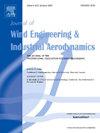Influence of incoming turbulence on aerodynamic forces of a high-speed train
IF 4.9
2区 工程技术
Q1 ENGINEERING, CIVIL
Journal of Wind Engineering and Industrial Aerodynamics
Pub Date : 2025-08-01
DOI:10.1016/j.jweia.2025.106184
引用次数: 0
Abstract
The influence of incoming turbulence on the aerodynamics of a high-speed train is numerically investigated using the Improved Delayed Detached Eddy Simulation (IDDES) combined with Synthetic Turbulence Generation (STG). The results reveal that increasing turbulence intensity significantly enhances the drag and lift coefficients of the train, with the rate of increase amplifying as the turbulence length scale grows. The incoming turbulence induces effects analogous to crosswind conditions, weakening the aerodynamic impact on the head carriage while accelerating airflow around the curved sections of the tail carriage. Moreover, the turbulent kinetic energy within the shear layers adjacent to the bogie cavity increases with turbulence intensity, facilitating enhanced flow ingress into the cavity and intensifying interactions with the bogie and cavity structures, thereby augmenting both drag and lift. Additionally, the presence of incoming turbulence produces a thinner boundary layer, characterized by a reduced shape factor and elevated viscous drag. Specifically, higher turbulence intensity leads to a smaller shape factor and a steeper velocity gradient, thereby increasing viscous drag. In contrast, larger turbulence length scales exhibit the opposite trend, manifesting as a decrease in viscous drag.

来流湍流对高速列车气动力的影响
采用改进的延迟分离涡模拟(IDDES)和合成湍流生成(STG)相结合的方法,研究了来流湍流对高速列车空气动力学的影响。结果表明,湍流强度的增加显著提高了列车的阻力系数和升力系数,且随湍流长度尺度的增大而增大。进入的湍流引起了类似侧风条件的影响,减弱了对头部车厢的气动冲击,同时加速了尾部车厢弯曲部分周围的气流。此外,与转向架空腔相邻的剪切层内的湍流动能随着湍流强度的增加而增加,从而增强了进入空腔的气流,加剧了与转向架和空腔结构的相互作用,从而增加了阻力和升力。此外,进入的湍流的存在产生了一个更薄的边界层,其特征是减小了形状因子和增加了粘性阻力。具体来说,湍流强度越高,形状因子越小,速度梯度越陡,从而增加了粘性阻力。相反,较大的湍流长度尺度表现出相反的趋势,表现为粘性阻力的减少。
本文章由计算机程序翻译,如有差异,请以英文原文为准。
求助全文
约1分钟内获得全文
求助全文
来源期刊
CiteScore
8.90
自引率
22.90%
发文量
306
审稿时长
4.4 months
期刊介绍:
The objective of the journal is to provide a means for the publication and interchange of information, on an international basis, on all those aspects of wind engineering that are included in the activities of the International Association for Wind Engineering http://www.iawe.org/. These are: social and economic impact of wind effects; wind characteristics and structure, local wind environments, wind loads and structural response, diffusion, pollutant dispersion and matter transport, wind effects on building heat loss and ventilation, wind effects on transport systems, aerodynamic aspects of wind energy generation, and codification of wind effects.
Papers on these subjects describing full-scale measurements, wind-tunnel simulation studies, computational or theoretical methods are published, as well as papers dealing with the development of techniques and apparatus for wind engineering experiments.

 求助内容:
求助内容: 应助结果提醒方式:
应助结果提醒方式:


